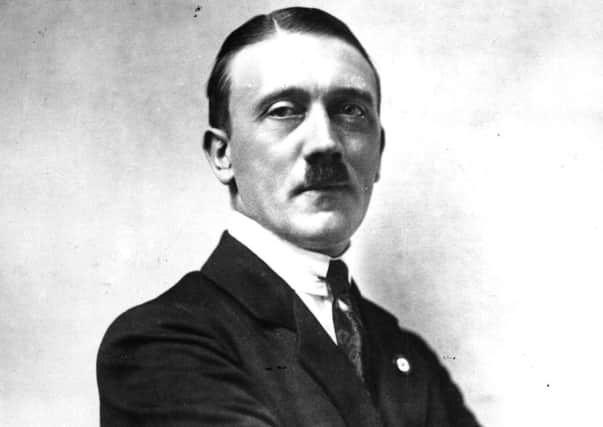Exploit Nazi tourism, Scots expert to tell Germany


Professor John Lennon, director of the Moffat Centre for Travel and Tourism Business Development at Glasgow Caledonian University, said there were huge opportunities for the country to exploit “dark tourism” by highlighting the horrors of the Hitler years.
He will deliver his message at a conference in Peenemunde, in northern Germany, next month to town planners, preservationists, historians, museum professionals and other experts to “identify the common issues” of dealing with structural and topographical relics of the Nazi era.
Advertisement
Hide AdAdvertisement
Hide AdThe venue is significant - Peenemunde was the manufacturing base for the V2 rockets that wreaked havoc on London from September 1944.
Some historians believe that had it opened earlier, the factory might have changed the course of the war.
Professor Lennon said that thoughtful exhibitions at the missile plant would inevitably attract crowds, as would shows at other Nazi sites, including the 1936 Berlin Olympic Stadium.
He said: “There is an inherent interest in this stuff.
“I’d like to say it’s because people are interested in history and want to learn from the past, but I think a big part is voyeurism.
“They want an experience that is a little bit different.”
Professor Lennon coined the term “dark tourism” in the 1990s to describe tourism and travel to sites historically associated with tragedy.
For example, people who toured battlefields and walked Jack the Ripper trails.
Just as crowds would travel in the 19th century to watch battles being fought, contemporary artists would seek out the precise spot in Dallas where JFK was shot.
Professor Lennon added: “You have to be sensitive to everything, from what you put in the shop to what you serve in the cafe.
Advertisement
Hide AdAdvertisement
Hide Ad“In Washington, they were incredibly careful about working out the right sort of catering, that it would be kosher, that it would be a calming place with nothing on the walls to distract you.
“Go to Auschwitz and you can still have the equivalent of a ham sandwich.
“That sensitivity isn’t there - maybe because it’s the real place and there are bigger issues.
“I’m not saying it doesn’t do a good job, but that was a bit jarring for me.
“I also found the content of the retail area a bit peculiar - postcards in concentration camps?
“The defence is that it’s about learning and education.
“Some of the stuff looks a bit like voyeuristic exploitation.”
Professor Lennon said Germany had a good record in interpreting its recent past.
He made reference to the Haus der Wannsee-Konferenz, the venue in 1942 for the meeting that determined the “final solution to the Jewish question”.
Advertisement
Hide AdAdvertisement
Hide AdThe contemporary museum there pulls no punches in drawing attention to the level of engagement across German society in the treatment of the Jews.
He added that the curators of Peenemunde’s technical museum “agonised” over the messages that their exhibitions sent out, with their mixture of scientific achievement and the consequential carnage.
Professor Lennon added: “I am convinced we have to preserve the architecture of Nazism to conserve and maintain this part of the past, even if it is the worst part.”
TOP ‘DARK TOURISM’ ATTRACTIONS IN GERMANY
• Dachau Camp Memorial - Built in 1933, Dachau was the first of the Nazi concentration camps opened in Germany, intended to hold political prisoners. It is located on the grounds of an abandoned munitions factory southeast of the medieval town of Dachau, about 16km north west of Munich.
• Memorial to the Murdered Jews of Europe, Berlin - The site consists of 2,711 gravestone-like pillars. Completed in 2005, it is the first formal German government-sponsored Holocaust memorial.
• Reichstag, Berlin - In front of the Reichstag building is a row of black marble slate slabs embedded in the ground, memorialising 96 politicians who were persecuted and murdered because their politics didn’t agree with Chancellor Hitler’s. They were dedicated in September 1992.
• Nazi Documentation Center, Nuremberg - A museum in the north wing in the of the unfinished remains of the Hitler’s Congress Hall in Nuremberg, the largest remaining monumental National Socialist building. Its permanent exhibition “Fascination and Terror”, concerned with the causes, connections, and consequences of Nazism, is housed in a glass spear-shaped construction which pierces the Congress Hall like a stake through its heart. It is also intended as a pun on the name of Albert Speer, Hitler’s favourite architect.
• Nuremberg trials courtroom, Palace of Justice - This building was the location of the Nuremberg Trials that were held in 1945-1949.
• Kathe Kollwitz Museum, Berlin - A museum filled with art inspired by the horrors of Berlin’s Nazi experience.